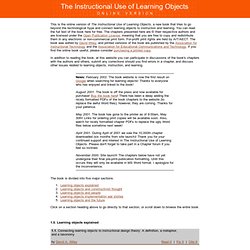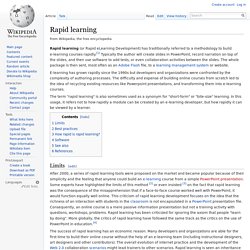

Flickr: Intercambio de fotos. Flickr: Intercambio de fotos. Metodologia Investigacion created by mcrojas based on Marketing Solutions. The Instructional Use of Learning Objects. This is the online version of The Instructional Use of Learning Objects, a new book that tries to go beyond the technological hype and connect learning objects to instruction and learning.

You can read the full text of the book here for free. The chapters presented here are © their respective authors and are licensed under the Open Publication License, meaning that you are free to copy and redistribute them in any electronic or non-commercial print form. For-profit print rights are held by AIT/AECT. The book was edited by David Wiley, and printed versions of the book are published by the Association for Instructional Technology and the Association for Educational Communications and Technology.
If you find the online book useful, please consider purchasing a printed copy. The book is divided into five major sections. 1.0. 2.0. 3.0. 4.0. Grupo 1: Diseño de materiales de aprendizaje. CoP: Best Practices. By Etienne Wenger [Published in the "Systems Thinker," June 1998] You are a claims processor working for a large insurance company.

You are good at what you do, but although you know where your paycheck comes from, the corporation mainly remains an abstraction for you. The group you actually work for is a relatively small community of people who share your working conditions. It is with this group that you learn the intricacies of your job, explore the meaning of your work, construct an image of the company, and develop a sense of yourself as a worker. You are an engineer working on two projects within your business unit. You are a CEO and, of course, you are responsible for the company as a whole. We now recognize knowledge as a key source of competitive advantage in the business world, but we still have little understanding of how to create and leverage it in practice. We frequently say that people are an organization's most important resource. Defining Communities of Practice. Intermates. GLO Maker. Instructional Media: Presentation. Www.oikodomos.org/private/downloads/deliverables/PR_EP1_001.pdf.
Creative Lounge. Creative showcase awards. Teach Elements: Project-Based Approaches. Learning Management System (LMS) Software for eLearning and Training - Coggno.com. Contact us - Easily create training sites. Rapid learning. Rapid learning (or Rapid eLearning Development) has traditionally referred to a methodology to build e-learning courses rapidly.[1] Typically the author will create slides in PowerPoint, record narration on top of the slides, and then use software to add tests, or even collaboration activities between the slides.

The whole package is then sent, most often as an Adobe Flash file, to a learning management system or website. E-learning has grown rapidly since the 1990s but developers and organizations were confronted by the complexity of authoring processes. The difficulty and expense of building online courses from scratch led to the idea of recycling existing resources like Powerpoint presentations, and transforming them into e-learning courses. The term "rapid learning" is also sometimes used as a synonym for "short-form" or "bite-size" learning. In this usage, it refers not to how rapidly a module can be created by an e-learning developer, but how rapidly it can be viewed by a learner.
CD Rayuela. Rayuela. Pasatiempos del Aula de Lengua. Willkommen in der Schellingstrasse 60. Tecnología Educativa - Material Didáctico Multimedia. Www.gabinetecomunicacionyeducacion.com/files/adjuntos/Metodología de elaboración de materiales didácticos multimedia accesibles.pdf. Inicio. In contexts in which we are, in which the "Information and Communication Technology' (ICT), become an element of development and empowerment of our schools and training institutions.
Pixel-Bit, Journal of Media and Education, aims to provide a platform for the exchange of ideas, experiences and research on the application of ICT, regardless of the format in which they are submitted and training contexts in which they develop, whether these formal, non-formal or informal, and educational level. Pixel-Bit, Journal of Media and Education, aims to be a channel of distribution and exchange of ideas and information between researchers in different countries and communities concerned about the introduction, improvement and understanding of ICT in training processes.
Design:Audience Analysis. ENTORNOS FORMATIVOS MULTIMEDIA: ELEMENTOS, TIPOLOGÍAS, CRITERIOS DE CALIDAD. Los recursos educativos multimedia, son materiales que integran diversos elementos textuales (secuenciales e hipertextuales) y audiovisuales (gráficos, sonido, vídeo, animaciones...) y que pueden resultar útiles en los contextos educativos. Distinguimos tres grandes grupos: Los buenos materiales multimedia formativos son eficaces, facilitan el logro de sus objetivos, y ello es debido, supuesto un buen uso por parte de los estudiantes y profesores, a una serie de características que atienden a diversos aspectos funcionales, técnicos y pedagógicos, y que se comentan a continuación: Al considerar la evaluación de la calidad de estos entornos formativos multimedia, hemos de distinguir al menos dos dimensiones: Por supuesto que la aplicación que se haga de los entornos dependerá de sus potencialidades intrínsecas, pero su eficacia y eficiencia dependerá sobre todo de la pericia de los estudiantes y docentes.